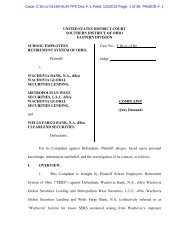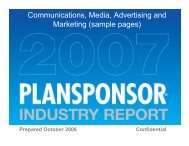Santomenno v. John Hancock Life Ins. Co. - PLANSPONSOR.com
Santomenno v. John Hancock Life Ins. Co. - PLANSPONSOR.com
Santomenno v. John Hancock Life Ins. Co. - PLANSPONSOR.com
You also want an ePaper? Increase the reach of your titles
YUMPU automatically turns print PDFs into web optimized ePapers that Google loves.
Case 2:10-cv-01655-WJM-MF Document 84 Filed 07/24/13 Page 5 of 10 PageID: 4186of Plaintiff’s claims, the <strong>Co</strong>urt does not reach the parties’ other arguments. 2 The <strong>Co</strong>urtwill address (1) the law governing ERISA fiduciary status, generally; (2) the lawgoverning ERISA fiduciary status in 401(k) fee cases; and (3) why <strong>John</strong> <strong>Hancock</strong> is notan ERISA fiduciary in this case.A. ERISA Fiduciary Status, GenerallyERISA requires each plan to have one or more named fiduciaries that are grantedthe authority to manage the operation and administration of the plan. 3 29 U.S.C. §1102(a)(1). In addition, an entity that is not a named fiduciary may be considered anERISA fiduciary in certain circumstances. ERISA provides that:a person is a fiduciary with respect to a plan to the extent(i) he exercises any discretionary authority or discretionary controlrespecting management of such plan or exercises any authority orcontrol respecting management or disposition of its assets,(ii) he renders investment advice for a fee or other <strong>com</strong>pensation,direct or indirect, with respect to any moneys or other property ofsuch plan, or has any authority or responsibility to do so, or(iii) he has any discretionary authority or discretionary responsibilityin the administration of such plan.29 U.S.C. § 1002(21)(A) (emphasis added).Because an entity is only a fiduciary “to the extent” that it possesses authority orcontrol over the plan, id., “fiduciary status is not an all or nothing concept.” Moench v.Robertson, 62 F.3d 553, 561 (3d Cir. 1995) (quotations omitted). <strong>Ins</strong>tead, courts “mustask whether [the entity] is a fiduciary with respect to the particular activity in question.”Srein v. Frankford Trust <strong>Co</strong>., 323 F.3d 214, 221 (3d Cir. 2003) (quotations omitted). “Inevery case charging breach of ERISA fiduciary duty, then, the threshold question is . . .whether [the entity] was acting as a fiduciary . . . when taking the action subject to<strong>com</strong>plaint.” Pegram v. Herdrich, 530 U.S. 211, 226 (2000).2 In their renewed motion to dismiss, Defendants raise arguments that they raised in their firstmotion, and also raise new arguments that they never asserted before. Plaintiffs argue thatDefendants are barred from raising new arguments by Federal Rule of Civil Procedure 12(g)(2)(“a party that makes a motion under this rule must not make another motion under this ruleraising a defense or objection that was available to the party but omitted from its earliermotion”). Because Defendants previously argued that <strong>John</strong> <strong>Hancock</strong> is not an ERISA fiduciary,and the <strong>Co</strong>urt decides the motion on that ground, it is unnecessary to decide the Rule 12(g)(2)issue.3 In this case, the Trustees are the named fiduciaries.5







